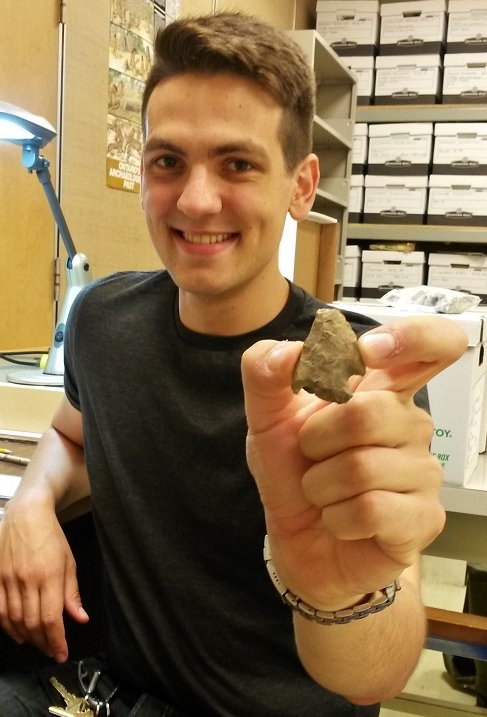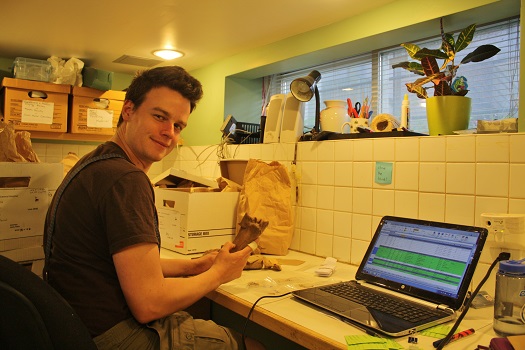From time to time, students and researchers in different fields of study come by our offices to use our collections and consult with our specialists. Here is where you can read more about the exciting projects they are working on…
Liam Browne (Master’s candidate, Trent University)
I am a Master’s candidates studying the late Paleoindian period at Trent University. My research aims to help us better understand changing mobility patterns in the Paleoindian period by examining the morphological variability in Hi-Lo projectile points.

The first Paleoindian colonists are thought to have entered Ontario between 11,000 to 10,500 years ago. These hunter-gathers would have been entering into a new and unknown land. The early Paleoindians are thought to have been highly mobile, to such a degree that archaeologists’ estimates of their mobility ranges are unusually large compared to historically known foraging societies.
As time passed, Paleoindians are proposed to have “settled in” to their new home and become familiar with local resources including both food and chert sources. Groups broadened their resource base to exploit a range of food products which may have previously been ignored or unknown. Consequently, populations are thought to have increased while mobility decreased. Populations became less wide-ranging and more regionalized compared to the early Paleoindians. This regionalization should in theory be visible in the archaeological record through inter-site toolkit variation.
Hi-Lo projectile points occur in Ontario around 10,000 years ago during a time of transition when Paleoindians are thought to be “settling in” to their landscape. To test the “settling in” hypothesis I am using a geometric morphometrics based approach to study Hi-Lo biface variability across Ontario. I am looking to see if certain characteristics of Hi-Lo points are specific to different areas in Ontario in an effort to test for regionalization in the archaeological record.
Hi-Lo points from ASI will form an important part of my study as I attempt to understand Hi-Lo biface variability. I hope that this work will help shed some light on an important part of Ontario’s history.
Kyle Forsythe (Master’s candidate, University of Western Ontario)

I am a Master’s candidate studying Great Lakes archaeology at the University of Western Ontario. My thesis work will contribute to expanding our knowledge of a relatively poorly known period in Ontario’s past, the Middle Archaic. Occurring between 4500 and 5500 years ago, this time span was populated by small bands of hunter gatherers who moved around the landscape to take advantage of seasonally available food resources, such as deer, turkey, and beaver.
Using a collection of stone tools from the Mount Albert site, excavated by ASI in 2013, my project aims to investigate the range of specific activities that Middle Archaic groups engaged with in their movements. Mount Albert reflects a relatively small occupation at the site (2,905 artifacts were excavated within 71 metres squared) that is not intermixed with other time periods, and therefore the artifacts were recovered in uniquely clear patterns that offer a glimpse into the activities that took place here. Specifically there are suggestions of activities of ceremonial import. Large quantities of bifaces, chipped stone tools that could be refined into blades and projectile points, were brought to the site and systematically smashed and burned. This pattern may allude to the ritual “killing” of tools that took a great amount of effort to manufacture and transport.
To test if this interpretation is true, my analysis of the artifacts will attempt to refit fragmented bifaces back together, like a huge puzzle. This seeks to prove that bifaces were broken intentionally by deliberate blows to their central surfaces, rather than accidentally in the process of production. If proven, Mount Albert will reveal an unprecedented view of ritual activities in the Middle Archaic of Southern Ontario.
ASI is pleased to support the research of Kyle. Our own work with the site, carried out by Doug Todd, reached similar conclusions. We are particularly interested in the biface refit program and look forward to seeing those results.
Sarah Striker (PhD candidate, Arizona State University)

I am a Ph.D. candidate in anthropology at Arizona State University. I have always been interested in how people work together as families, clans, villages, and larger groups such as tribes. My research focuses on the relationship between how people interact and work together as members of these groups and how they understood these relationships in the past. My focus is the archaeology of the Great Lakes region and Northeastern America, and in particular, the Late Woodland period just prior to the widespread presence of Europeans in this area.
My dissertation research focuses on an important period of social change for the Ancestral Wendat people of what is now southern Ontario. At 1400 C.E., the Ancestral Wendat lived in small, dispersed villages. Each of these small villages was home to a few hundred people in several longhouses. By around 1550 C.E, their descendants had aggregated into a few large, well-integrated villages of more than a thousand people. This process is called “coalescence” and archaeologists have studied how coalescence happens in many different kinds of societies all over North America. I am studying the social dynamics of coalescence to understand how relationships among individuals and groups of people changed during this period, and how this might be related to why and how they were able to make these much larger communities work.

I have been coming to ASI to study pottery from the Mantle site, which is a great example of a coalescent community. Mantle was occupied in the first half of the sixteenth century. This village was very large and its layout was carefully planned before people began building the houses and walls of the village. This tells us that the people who built the Mantle community were working together as a whole community rather than as smaller groups. I have been studying the pottery at the Mantle site to learn about the relationships between the people who lived there. I am making observations about how the pottery was made to figure out how many different groups of people were making pottery and who was using it. This will help us to understand how people worked together at the Mantle site, how different households within the village were related to one another, and the Mantle village was trading with communities in other parts of Ontario or New York.
The photo above is from Sarah’s research – it shows a cross-section of a pot fragment from Mantle. Sarah explains, “You can see evidence of how the pot was made in the way that the clay is pulled and layered. You can also see larger pieces of rock that were added to make the clay the right consistency.”
Eric Guiry (PhD Candidate, University of British Columbia)

In collaboration with ASI, I am undertaking an archaeological bone chemistry project that will help facilitate reconstructions of the life histories of past domesticated and wild animals in Ontario. This project uses stable isotope bone chemistry to understand the uses importance of animals and animal products during different periods and among different groups. Based on the premise that, ‘you are what you eat’ and that certain foods can have distinctive chemical compositions, stable carbon, nitrogen, and sulfur isotope analyses of ancient tissues preserved within archaeological bone can provide information about the way in which an individual was raised, the foods they consumed, and the places they had lived. These analyses will be performed using the stable isotope ratio mass spectrometry laboratory at the Department of Anthropology at University of British Columbia, in Vancouver, Canada.
In particular, this work uses dietary and mobility information that is recorded in the form of chemical signatures in animal bones and teeth that have been excavated by ASI at various sites in Ontario to understand where and how past animals fed. This information is useful because the life histories of animals often reflect longer term relations with humans and can thus be used to address a wide variety of questions about past human activities associated with subsistence and trade.









